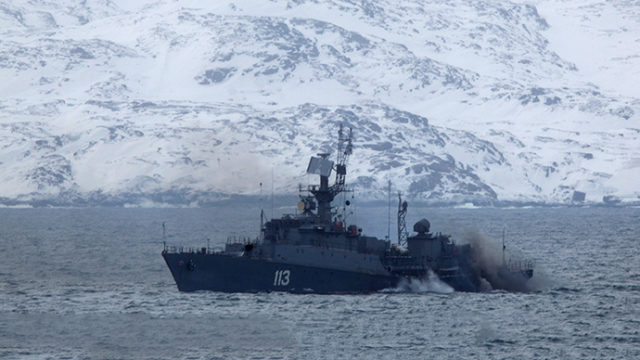
Russia Considers Developing a New Fleet in the Arctic
Publication: Eurasia Daily Monitor Volume: 19 Issue: 10
By:

The Russian Ministry of Defense reportedly plans to create a new naval formation, an Arctic Fleet, to ensure the safety of Russia’s Northern Sea Route (NSR) and the Arctic littoral region as a whole (TASS, October 7, 2021). According to experts, the creation of this separate Arctic naval unit will free up the Northern and Pacific fleets to focus on purely combat missions. The Arctic Fleet will deal only with the NSR and report directly to the Ministry of Defense (Rossiyskaya Gazeta, October 8, 2021). That said, the proposed Arctic Fleet could also provide invaluable naval backup in the event that Russia’s Northern Fleet is crippled in military action. As the Russian Academy of Rocket and Artillery Sciences’ (RARAN) Deputy President Konstantin Sivkov noted last May, the Northern Fleet Joint Strategic Command (USC), which is currently responsible for the security of the Russian Arctic, would likely be destroyed in a potential conflict with the United States Navy (Lenta, May 21, 2021.
While there has been little concrete information since the initial TASS reporting in October of last year, the revealed concept tacitly acknowledges the rising importance to Russia of the passage of merchant marine traffic via the NSR. This sea lane follows the Russian shore, from the country’s western maritime border with Norway all the way to the Bering Sea. Responsibility for safeguarding Russia’s Arctic coast is currently shared between the Northern and Pacific fleets.
For Russia and Russian commercial shipping, a unique advantage of the Northern Sea Route over all other oceanic maritime corridors, is that it lies entirely within the country’s territorial waters, as defined under the 1982 United Nations Convention on Law of the Sea (UNCLOS). This provides a level of security that international routes through the Baltic, Black or Mediterranean seas do not, since, in a crisis, the latter are vulnerable to hostile foreign naval interference, for example in the form of blockades.
The Russian hydrocarbon industry has great hopes for expanded use of the NSR, but so do other economic sectors. According to the deputy chairperson of the State Commission for the Development of the Arctic, Vladimir Panov, Russia’s modern Arctic cargo fleet is composed of more than 40 ships that have been built over the past 4 years and could triple to 120 vessels by 2030. Panov added that in 2020, 52 foreign companies also applied for permission to utilize the Northern Sea Route (Neftegaz.ru, June 24, 2021).
Yet in order to expand the NSR’s navigational season, the Russian merchant marine faces an imminent shortage of nuclear-powered icebreakers. Adding a fifth to the current fleet of four icebreakers would expand the season from eight to nine months, but according to the head of Rosatom State Corporation’s NSR Directorate, Viacheslav Ruksha, it will soon be necessary to decide how many 120-megawatt nuclear large icebreakers will be needed to ensure the traffic along the NSR after 2039, a number that he estimates to be a minimum of five to seven, and preferably ten to twelve (Rossiyskaya Gazeta, January 18, 2022). Rosatom’s subsidiary Atomflot operates Russia’s icebreaker fleet. In December Atomflot’s fifth nuclear-powered icebreaker, laid down in 2015, Sibir (Siberia), was commissioned at the Baltic Shipyard, owned by United Shipbuilding Corp (TASS, December 24, 2021). Sibir will be home ported in Murmansk, from where it will assist in keeping the NSR navigable (Rosatomflot.ru, January 13, 2022).
The Russian government’s interest in developing the Northern Sea Route is long-standing: “The Strategy for the Development of the Arctic Zone of the Russian Federation and Ensuring National Security for the Period until 2020” was approved by President Vladimir Putin on February 20, 2013 (Government.ru, June 25, 2019). And over the past decade, the NSR’s traffic has progressively increased. The NSR directorate reported that by the end of 2021 it exceeded 33.5 million tons, surpassing the 2020 volume of 32.97 million tons (Rossiyskaya Gazeta, January 18, 2022).
Rosatom, accordingly, has major expansion plans to start designing elements for a future container line through the Northern Sea Route, including ice-class container ships and two port transfer hubs. At the “Economic Corridor Through the NSR as a New Trend in World Trade” forum at EXPO-2022 in Dubai, Rosatom first deputy director general and development and international business director Kirill Komarov assured that the new containerized traffic route would become operational within three years (TASS, January 18). Relatedly, as part of the Russian government’s broader Arctic infrastructure initiatives, on January 14, Putin directed Russian Prime Minister Mikhail Mishustin to “submit proposals for the creation of a railway route to the Barents Sea” within three months (Kremlin.ru, January 14).
Russia’s proposed Arctic Fleet, if implemented, will provide services analogous to a coast guard to Russia’s NSR merchant marine traffic, likely to include more extensive foreign shipping in the near future. This will free both the Northern and Pacific fleets from the tedious chore of providing security along Russia’s 4,300-mile-long Arctic coast. As World War II proved, however, Arctic convoy duty in Russian waters can quickly become a high-risk endeavor—a consideration that Russian planners will undoubtedly bear in mind about their new project.



